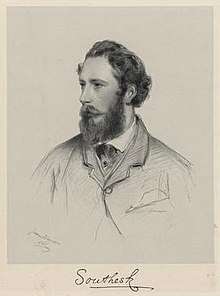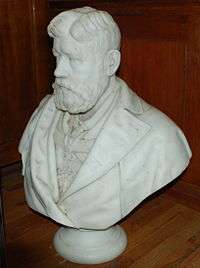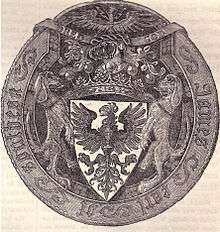James Carnegie, 9th Earl of Southesk
James Carnegie, 9th Earl of Southesk KT (16 November 1827 – 21 February 1905) was a Scottish nobleman, explorer and poet.

Early life
Born in Edinburgh, on 16 November 1827, Southesk was the son of Sir James Carnegie, 5th Baronet and Charlotte Lysons, daughter of the Rev'd Daniel Lysons. He attended the Edinburgh Academy, received his military training at the Royal Military Academy Sandhurst and in 1845 joined the 92nd Regiment of Foot, before transferring to the Grenadier Guards the next year, with whom he served for three years. In 1849 he was appointed Lord Lieutenant of Kincardineshire, a position he continued to hold until 1856, when he sold his lands in Kincardineshire.
Through his great-great-great grandfather, who was the fourth son of David Carnegie, 1st Earl of Southesk, James was the heir to the earldom of Southesk and the lordship of Carnegie. The fifth earl was involved in the Jacobite rising of 1715 and was attainted, with his titles and estates forfeited. However, in 1855 Sir James Carnegie obtained a reversal of his kinsman's attainder by Act of Parliament and became the ninth Earl of Southesk. He held the office of Lord-Lieutenant of Kincardineshire between 1849 and 1856. He succeeded as the 6th Baronet Carnegie, of Pittarrow, co. Kincardine on 30 January 1849. He succeeded as the 9th Lord Carnegie of Kinnaird on 2 July 1855, after the original precedence by reversal by Act of Parliament of the Act of Attainder. He succeeded as the 9th Lord Carnegie of Kinnaird and Leuchars on 2 July 1855, after the original precedence by reversal by Act of Parliament of the Act of Attainder. He succeeded as the 9th Earl of Southesk on 2 July 1855, after the original precedence by reversal by Act of Parliament of the Act of Attainder. He was created 1st Baron Balinhard, of Farnell, Forfar on 7 December 1869. He held the office of Deputy Lieutenant of Forfarshire.[1]
Marriage
In 1849 Southesk married Lady Catherine Hamilton Noel (1829–1855), daughter of Charles, Earl of Gainsborough on 19 June 1849 at Exton Park, Rutland, England. They had one son and three daughters, before Catherine's death in 1855 at the age of twenty-six. In 1860 Southesk married Lady Susan Catherine Mary Murray (1837–1915), eldest daughter of Alexander, Earl of Dunmore. They had three sons and four daughters. Lord Southesk died in February 1905, aged seventy-seven. He was succeeded by his son from his first marriage, Charles Noel Carnegie.
His children were[2]:
By Catherine-
- Lady Arabella Charlotte, who married DL Samuel Romilly the paternal grandson of Samuel Romilly and maternal grandson of Gilbert Elliot-Murray-Kynynmound, 2nd Earl of Minto. They had four children.
- Constance Mary, who married Victor Bruce, 9th Earl of Elgin. They had issue.
- Lady Beatrice Diana Cecilia Diana Cecillia, married Rev. Henry Holmes Stewart and had a son.
- Charles Noel Carnegie, 10th Earl of Southesk
By Susan-
- Sir Lancelot Douglas Carnegie, GCVO, KCMG
- Lady Dora Susan, married Maj. Ernest de Rodakowski-Rivers. Had issue.
- Elizabeth Erica (1864-1897). Died unmarried.
- Helena Mariota (13 October 1865-24 January 1943). Unmarried.
- Katherine Agnes Blanche Carnegie, married Courtenay Morgan, 1st Viscount Tredegar. Had issue.
- Robert Francis (6 May 1869-13 May 1947), married Violet Fraser and had issue.
- David Wynford Carnegie (23 March 1871-27 November 1900). Died unmarried.
1859 Canadian Expedition
.jpg)
_(14748622314).jpg)
In 1859, after the death of his wife, the Earl was advised that to improve his health he should travel to a place where he could live an open-air life and hunt. In 1859, at the age of 32, he embarked on a trip to western Canada.[3]
Carnegie wrote that the reason for the expedition was to, "travel in some part of the world where good sport could be met with among the larger animals, and where, at the same time, I might recruit my health by an active open-air life in a healthy climate."
— James Carnegie, 9th Earl of Southesk
Southesk left Liverpool on April 15, 1859 on a Cunard paddle-wheeler called the “Africa” for North America. Eventually, he ended up in St. Paul, Minnesota, the jumping off point for his expedition and then continued on north to Fort Garry, the Hudson's Bay Company's western headquarters in the Red River Colony. In June, Southesk, headed out west and over the next seven months, the expedition travelled more than 4,000 kilometres across the northern prairies to the Rocky Mountains. The plan was to head west out of Fort Garry into Rupert's Land, to hunt bears and bison. He arrived at Fort Edmonton on August 1.[4] At the fort he paused to buy horses, hired a Metis guide called Antoine Blandoine and built enough pack saddles to haul his outfit into the mountains west of Cadomin to pursue bighorn sheep. The journey, in early September, took the expedition up the Athabasca River to the McLeod River and finally, the Medicine Tent River, noting that he was now in country that, "no European had ever seen, where bears and wild sheep were certain to be abundant." The expedition then crossed over Southesk Pass, to the Kootenay Plain s of the Saskatchewan River valley, in present-day Alberta. The expedition followed the Siffleur River, crossed over the Pipestone Pass, and followed the Pipestone River to the Bow River. After camping near Cascade Mountain, the Earl nearly crossed paths with another explorer, James Hector at a time when there were very few Europeans in the Canadian Rockies.[5] On the expedition, the Earl of Southesk climbed a mountain, located 6 km north of Mount Southesk and erected a cairn on top that can still be seen today. He wrote in his journal, "I am the first European who has visited this valley, and if I might have the geographic honour of giving my name to some spot of earth, I should choose the mountain near which the two rivers rise."[6]
For the expedition he employed a number of Métis guides and scouts; James McKay, John McKay, George Klyne, John "Piscan" Munroe, Baptiste La Grace, James "Little Dog" Short, Antoine Blandion, Pierre Desnomme, Thomas Arinwakena, and Duncan Robertson.[7] These men were experienced buffalo hunters. During this trip which took him west to Fort Edmonton and into the Rocky Mountains he commissioned and collected several Métis and aboriginal artifacts.[3]
While on his trip, the Earl received considerable support from the Hudson's Bay Company. HBC Governor Sir George Simpson helped the Earl arrange for guides, supplies and horses. He gave the Earl a map and instructed HBC employees to show him “every attention.”.[3]
In 1875 he wrote, "Saskatchewan and the Rocky Mountains" which described his travels.
An exhibit dedicated to the Earl's Canadian prairie trip, including a life-sized statue of a large plains grizzly bear he killed while on a bison hunt on the nearby prairie,[8] can be found at Ancient Echoes Interpretive Centre in Herschel, Saskatchewan.[9]
The Southesk Collection at the Royal Alberta Museum
Throughout the 1859 Canadian expedition, Southesk collected objects made by First Nations and Métis people whom he met in the course of his travels. The artifacts returned home with Southesk to Kinnaird Castle, the family estate in Scotland where they remained for the next 146 years, until 2006, when the earl's descendants put them up for auction at Sotheby's in New York.
The Royal Alberta Museum purchased many of the items put up for sale. for $1.1 million.[4] Although relatively small, the Southesk collection is historically significant given that objects from the northern Plains dating to the 1850s are rare and that many of the artifacts are of exceptional quality. Although modest in size, the collection includes work from at least five distinct cultures — Plains Cree, Blackfoot, Métis, Nakoda and Anishnaabe. The current Earl of Southesk subsequently donated five additional items linked with the collection.[10]
Publications

Novels
- Herminius: a romance. (1862)
- Suomiria: a fantasy (1899)[11]
Short Fiction
- Some Sort of Madness [excerpt] (1982) [only as by Earl of Southesk][12]
Non-Fiction

- Saskatchewan and the Rocky Mountains: a diary and narrative of travel, sport, and adventure, during a journey through the Hudson's Bay Company's territories, in 1859 and 1860. (1875)[13]
- Origins of Pictish symbolism; with notes on the sun boar and a new reading of the Newton inscriptions. (1893)[14]
- The Ogham Inscriptions of Scotland. (1885)
- Britain's art paradise; or, Notes on some pictures in the Royal Academy, (1871)
Poetry
Catalogue
- Catalogue of the collection of antique gems formed by James, ninth earl of Southesk, K.T.; edited by his daughter Lady Helena Carnegie. (1908)[19]
Honours
- Fellow of the Royal Geographical Society (1860)
- Knight of the Order of the Thistle. (1869) on Prime Minister Gladstone's recommendation.
- Honorary LL.D. from St. Andrews. (1872)
- Honorary LL.D. from Aberdeen University. (1875)[20]
Death
The 9th Lord Southesk died on February 21, 1905, aged seventy-seven while at his home in Kinnaird Castle in Scotland. He was succeeded by his son from his first marriage, Charles Noel Carnegie.
References
- Cokayne, George Edward, ed. (1983). The Complete Baronetage (reprint ed.). Alan Sutton Publishing.
- "James Carnegie, 9th Earl of Southesk". geni_family_tree. Retrieved 1 February 2019.
- "National Poetry Month - The Earl of Southesk, Other". Fort Edmonton Park. 28 April 2012. Retrieved 31 January 2019.
- Simons, Paula (31 July 2009). "Earl of Southesk saddles up to trace ancestor's journey". The Edmonton Journal. Retrieved 7 September 2019.
- "James Carnegie".
- "Southesk Cairn".
- Barkwell, Lawrence. https://www.scribd.com/document/187295746/Southesk-Expedition-Metis-Guides
- "The Plains Grizzly Bear - Saskatchewan Historical Markers on Waymarking.com". www.waymarking.com. Retrieved 1 February 2019.
- "Ancient Echoes Interpretive Centre". www.ancientechoes.ca. Retrieved 31 January 2019.
- "Southesk Collection". Friends of Royal Alberta Museum Society. Retrieved 31 January 2019.
- Southesk, James Carnegie (1976). Suomiria: a fantasy. Supernatural and occult fiction. New York: Arno Press. ISBN 9780405081705.
- "Summary Bibliography: James Carnegie, 9th Earl of Southesk". www.isfdb.org. Retrieved 31 January 2019.
- Southesk, James Carnegie (1875). Saskatchewan and the Rocky mountains. A diary and narrative of travel, sport, and adventure, during a journey through the Hudson's bay company's territories, in 1859 and 1860. Edinburgh: Edmonston and Douglas.
- Southesk, James Carnegie (1893). Origins of Pictish symbolism: with notes on the sun boar and a new reading of the Newton inscriptions. Edinburgh: D. Douglas.
- Southesk, James Carnegie (1876). Lurida lumina. Edinburgh: Edmonston.
- Southesk, James Carnegie (1884). The burial of Isis, and other poems. Edinburgh: D. Douglas.
- Southesk, James Carnegie (1875). Jonas Fisher, a poem in brown and white. London: Trübner.
- Southesk, James Carnegie (1876). Greenwood's farewell and other poems. London: Straham.
- Southesk, James Carnegie; Carnegie, Helena Mariota (1908). Catalogue of the collection of antique gems formed by James, ninth earl of Southesk. London: B. Quaritch.
- Fryer, S.E. (1912). "Carnegie, James". In Lee, Sidney. Dictionary of National Biography, 1912 supplement. 1. London: Smith, Elder. pp. 315–316.
External links
- Hansard 1803–2005: contributions in Parliament by the Earl of Southesk
- The Lost Statue of the Earl of Southesk
- Kinnaird Castle
- Fort Edmonton Park
- Royal Alberta Museum
- Ancient Echoes Interpretive Centre
| Honorary titles | ||
|---|---|---|
| Preceded by Sir Thomas Burnett |
Lord Lieutenant of Kincardineshire 1849–1856 |
Succeeded by The Earl of Kintore |
| Peerage of Scotland | ||
| Preceded by James Carnegie under attainder |
Earl of Southesk 1855–1905 |
Succeeded by Charles Carnegie |
| Peerage of the United Kingdom | ||
| New creation | Baron Balinhard 1869–1905 |
Succeeded by Charles Carnegie |
| Baronetage of Nova Scotia | ||
| Preceded by James Carnegie |
Baronet (of Pittarrow, Kincardineshire) 1849–1905 |
Succeeded by Charles Carnegie |